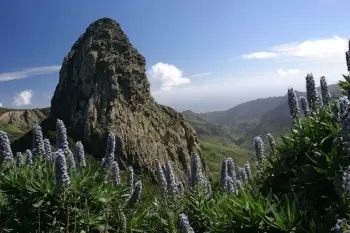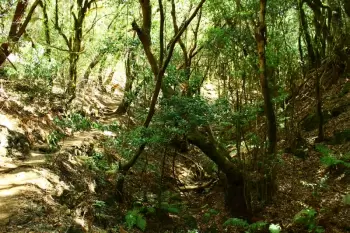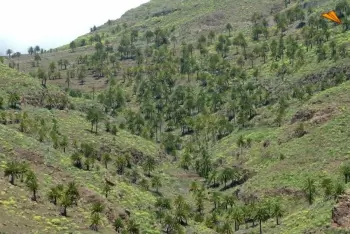Nature in La Gomera
Climate - Ressources - Culture - Histoire - Nature - Garajonay National Park - Protected areas
Fauna - Flora - Geology - Silbo Gomero
The natural landscape of La Gomera is a work of art realized by the erosion.
 Erosion has acted continuously to dismantle a part of the insular structure. Therefore erosive forms such as the ravines, the marine cliffs, and differential reliefs such as large rocks dominate le landscape.
Erosion has acted continuously to dismantle a part of the insular structure. Therefore erosive forms such as the ravines, the marine cliffs, and differential reliefs such as large rocks dominate le landscape.
The combination of geomorphological features and the climate have given rise to numerous ecological environments, from the warm, dry atmospheres of the south to the fresh, humid climate of the middle altitudes and the peaks.
The central peaks of La Gomera, often enveloped in fog, are home to a fascinating, luscious rain forest, whose permanent greenery is frequently imbibed with mist, and contrasts sharply with the aridity of the coast and lower zones of the island.
 This vegetable growth is denominated laurisilva, alluding to the greater part of the ample variety of arboreal species found here whose leaves are similar to those of the laurel tree. This type of leaf is an indication of its adaptation to the humid environment and mild temperature of the north and central zones where the laurel forest flourishes.
This vegetable growth is denominated laurisilva, alluding to the greater part of the ample variety of arboreal species found here whose leaves are similar to those of the laurel tree. This type of leaf is an indication of its adaptation to the humid environment and mild temperature of the north and central zones where the laurel forest flourishes.
The vegetation of La Gomera, like of the other mountainous islands of the archipelago, is conditioned by the height and orientation of each zone.The lower areas with a scarcity of rainfall are covered by a very characteristic brushwood, made up of spurges and thistles, and others crass plants such as verodes and cardoncillos
 On the more humid slopes of the northern facade and in the bottoms of the ravines, palm groves and the remains of ancient thermopile forest, formed by wild olive trees, almacigos and Phoenician junipers are found. Nowadays these have been pushed out by the cultivated lands, but in Vallehermoso there is still a considerable extension of Phoenician juniper.
On the more humid slopes of the northern facade and in the bottoms of the ravines, palm groves and the remains of ancient thermopile forest, formed by wild olive trees, almacigos and Phoenician junipers are found. Nowadays these have been pushed out by the cultivated lands, but in Vallehermoso there is still a considerable extension of Phoenician juniper.


